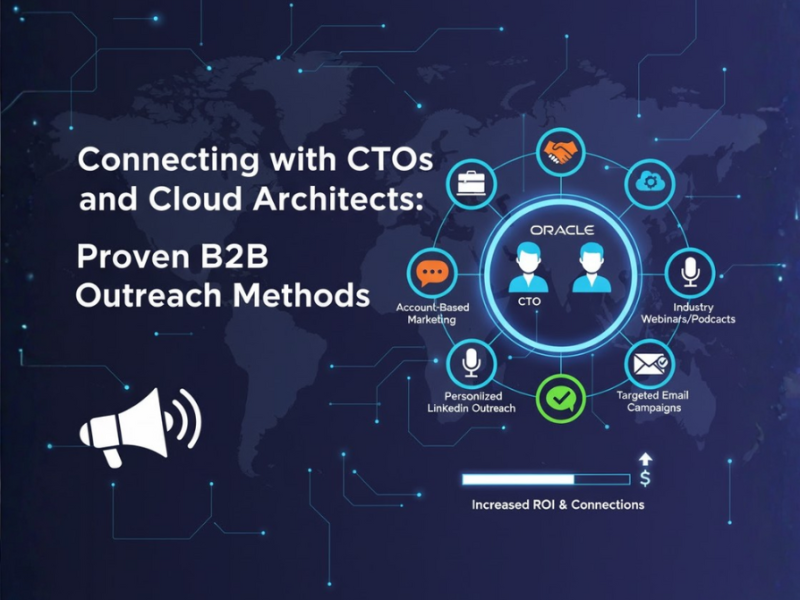In the fiercely competitive landscape of B2B marketing, the days of broad, untargeted outreach are rapidly becoming a relic of the past. Modern businesses demand precision, personalization, and a clear path to ROI.
This shift has been significantly influenced by the accelerating adoption of cloud technologies, with Amazon Web Services (AWS) emerging as the undeniable leader in providing robust, scalable infrastructure for companies of all sizes.

For forward-thinking B2B marketers, this pervasive cloud presence has transformed AWS user data into an invaluable goldmine for targeted lead generation and improved campaign performance.
The Evolution of B2B Outreach
The traditional spray-and-pray approach to B2B outreach is inefficient and costly. Today, the emphasis is on identifying and engaging with prospects who genuinely need and will benefit from a specific product or service. The rise of cloud computing, particularly the dominance of AWS, has created an unprecedented opportunity for this kind of precision targeting.
Businesses are increasingly building their entire digital infrastructure on AWS, making the amazon web services users list a critical asset for any B2B company looking to sell complementary solutions. Understanding who uses AWS and how they use it allows for a level of segmentation and personalization previously unattainable.
Understanding the AWS Ecosystem in B2B Context
AWS is far more than just a collection of servers; it’s a comprehensive ecosystem of over 200 services, ranging from computing power and storage to databases, analytics, machine learning, and more. From nimble startups to established enterprise IT departments, SaaS providers, and DevOps teams, a vast array of businesses leverage AWS to power their operations.
For B2B lead generation, knowing which companies utilize AWS – and more importantly, which specific services they employ – provides deep insights into their technological needs, operational scale, and potential pain points. This understanding is the foundation for highly effective, solution-oriented outreach.
What is an Amazon Web Services Users List?
At its core, an amazon web services users list is a curated database of companies and contacts that are known to use AWS. Such lists typically include valuable data points like company size, industry, approximate revenue, and crucial insights into their existing tech stack.
The true power, however, lies in segmenting these lists by the specific AWS services they consume.
- Amazon EC2 users list: Targeting compute-intensive buyers. Companies on this list are heavily reliant on virtual servers, indicating a need for solutions related to workload optimization, performance monitoring, migration services, or cost management for their computing infrastructure.
- Amazon S3 users list: Reaching storage-heavy use cases. Businesses utilizing Amazon S3 for data storage are prime candidates for backup and recovery solutions, data security platforms, data analytics tools, or even content delivery networks. Their data volume suggests specific challenges and opportunities.
- Amazon RDS users list: Ideal for database-centric product targeting. Companies on this list depend on managed relational databases. They might be interested in database performance tuning, migration tools to different database types, security for sensitive data, or analytics solutions that integrate with their databases.
- Amazon ElastiCache users list: Pinpointing real-time application developers. Users of Amazon ElastiCache, a managed in-memory data store, are typically building high-performance, real-time applications. This segment is highly relevant for tools that enhance application performance, provide advanced caching strategies, or offer real-time analytics.
This granular segmentation allows B2B marketers to craft highly refined messaging, personalizing outreach to address the specific challenges and opportunities associated with each AWS service. It’s about speaking directly to their current technological environment.
B2B Outreach Use Cases with AWS Users Lists
The practical applications of leveraging amazon web services users list are diverse and impactful:
- Example 1: Promoting cloud optimization tools to EC2 users. A company offering cost management or performance monitoring software for virtual machines can directly target the amazon ec2 users list. Their outreach can highlight how their solution helps reduce expenditure or improve application speed on EC2 instances.
- Example 2: Selling backup/security solutions to S3 users. For providers of data backup, disaster recovery, or advanced security platforms, the amazon s3 users list is a golden opportunity. Messaging can focus on data compliance, ransomware protection, or efficient data archiving.
- Example 3: Reaching DevOps teams using RDS and ElastiCache. Tools for continuous integration/continuous deployment (CI/CD), database automation, or application performance monitoring (APM) are highly relevant to organizations on the amazon rds users list and amazon elasticache users list. These companies prioritize efficiency and speed in their development cycles.
- Example 4: SaaS vendors identifying ideal buyers using amazon web services users list. A SaaS company offering a solution that integrates deeply with AWS can identify prospects whose existing infrastructure aligns perfectly. For instance, a data visualization SaaS might target companies using Amazon Redshift (a data warehousing service) or Amazon RDS, knowing their data is already in a compatible format.
Read More: Benefits Of Infor CRM Software
Strategies to Leverage AWS User Lists in Campaigns
Successful implementation requires more than just acquiring a list.
- Segment and clean data effectively: Further segment the amazon web services users list based on industry, company size, geography, or specific job titles to create hyper-targeted campaigns. Regularly clean and de-duplicate the data to ensure accuracy.
- Integrating the list with CRM and marketing automation: Seamlessly import the segmented data into your CRM (e.g., Salesforce) and marketing automation platforms (e.g., HubSpot, Marketo). This allows for automated nurturing sequences and streamlined sales follow-ups.
- Customizing email and LinkedIn outreach using AWS tech signals: Craft email subject lines and LinkedIn messages that explicitly reference their AWS usage. For example, “Boosting your Amazon EC2 performance: A guide for [Company Name]” or “Solving data replication challenges for Amazon RDS users.”
- Timing and frequency best practices: Avoid bombarding prospects. Instead, plan a strategic sequence of outreach, providing value with each touchpoint, such as offering whitepapers on AWS optimization or webinars on a relevant AWS service.
Compliance, Ethics & Data Accuracy
Leveraging amazon web services users list comes with critical responsibilities.
- Ensuring the AWS users list is GDPR/CCPA compliant: Data privacy regulations are paramount. Ensure any acquired list adheres to GDPR, CCPA, and other relevant regional data protection laws. This often means focusing on publicly available data or lists where contacts have explicitly opted in.
- Vetting list vendors and validation methods: Thoroughly research and vet any third-party list providers. Inquire about their data sources, update frequency, and validation processes. Reputable vendors will have robust methods for ensuring accuracy and compliance.
- Importance of opt-in and updated contact data: Prioritize building your own opt-in lists over time. Even with purchased lists, aim to convert contacts into opt-in subscribers. Outdated or inaccurate data not only leads to wasted efforts but can also harm your sender reputation.
Read More: Email Appending Services
Future Trends in Cloud-Based Lead Targeting
The evolution of B2B outreach through cloud data is ongoing:
- Rise of AI for enrichment and scoring of AWS data: Artificial intelligence will increasingly enhance amazon web services users list by enriching profiles with additional firmographic and technographic data, and by scoring leads based on their likelihood to convert.
- Predictive outreach based on cloud service usage trends: Advanced analytics will identify patterns in AWS service adoption and usage, allowing businesses to predict future needs and proactively reach out with highly relevant solutions.
- Integration of buyer intent + AWS usage signals: Combining insights from AWS usage with buyer intent data (e.g., prospects researching specific keywords or competitors) will create an even more powerful targeting model, identifying companies actively seeking solutions that align with their AWS infrastructure.
Final Thoughts: Is AWS-Based Targeting the New Norm?
The undeniable shift to cloud infrastructure makes the AWS ecosystem a central pillar of modern B2B outreach. By intelligently leveraging amazon web services users list, and specifically segmenting by services like amazon ec2 users list, amazon s3 users list, amazon rds users list, and amazon elasticache users list, businesses can achieve unparalleled precision in their lead generation efforts.
Key metrics to track in AWS-driven campaigns include conversion rates from AWS-segmented lists, the cost per qualified lead, and overall ROI compared to traditional outreach methods. The data consistently shows that targeted, personalized campaigns outperform generic ones.
It’s time to evaluate your current targeting stack. Are you truly maximizing the potential of cloud adoption for your B2B sales and marketing?
Considering AWS user segmentation is no longer an optional enhancement; it’s rapidly becoming the new norm for driving high-impact, revenue-generating B2B outreach. Embrace this shift, and unlock a future of more efficient and effective lead generation.


